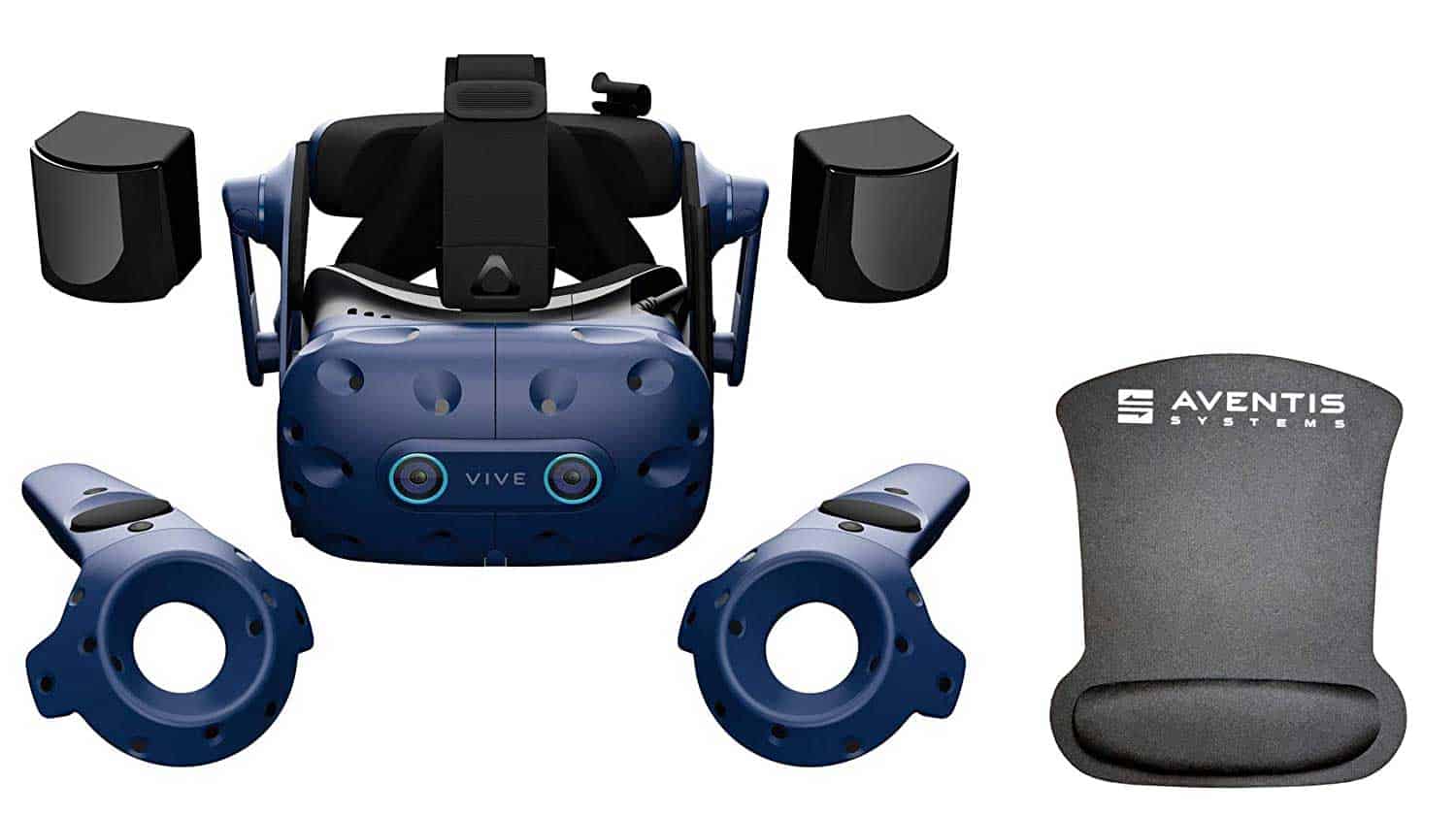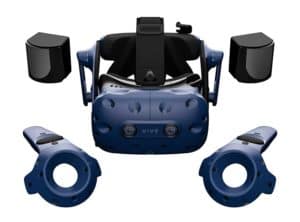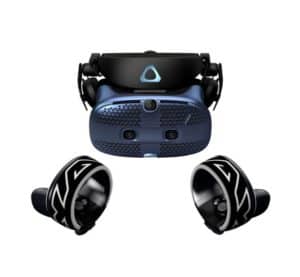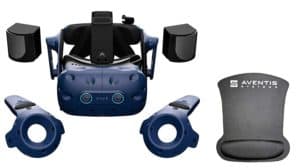Best HTC VR Headset

Table of Contents
With a headset and motion tracking, VR is an exciting, incredible way of transporting yourself to different places while not leaving your house. With VR you can roam around a virtual space as if you’re actually there, and immerse yourself in video games in a way you never have before.
VR has been gaining traction in recent years, thanks to video game manufacturers like PlayStation getting in on the VR action with their own headsets; the accessibility of ultra-cheap products like the Google Cardboard; and not to mention the compelling games and experiences VR headsets have to offer.
However, VR is also in a state of flux. Some models disappear as quickly as they appeared. HTC is no different, but below we’ve reviewed three of the best. You’ll also find a buyer’s guide that lets you know what to expect from higher-end VR headsets such as HTC’s models, and answers to some frequently asked questions.
Products at a Glance
How we picked
We prioritized headsets which produced vivid and clear imagery. A comfortable wear was essential for long gaming sessions, as was durability and build quality. We tried to include a range of budgets.
Remember, if you’re not after HTC headsets, we’ve also got a guide to the best Valve headsets and best Google VR headset.
Product Reviews
- Improved visual fidelity: The higher resolution makes for an impressive, immersive experience.
- Built-in headphones: These headphones not only make for a comfortable and immersive experience but a more secure experience too.
- Improving game library: The Vive Pro definitely has more gaming options than the original Vive.
- Difficult to troubleshoot: The shakiness with all non-new hardware leads to some issues that are difficult to solve.
There is a lot to celebrate about the HTC Vive Pro. Firstly, its headphones sit directly on top of your ears, are adjustable in height, and have volume controls which means you no longer have to take off the headset to adjust the volume between sessions.
The Vive Pro also has a harness that holds the headset more firmly than the velcro straps on the original Vive did. The harness works to keep the headset from moving during particularly vigorous and intense gaming moments, and also keeps the infamous and dreaded head strain at bay that may occur after wearing a headset for an extended period of time. A knob on the back will tighten the headset for a better fit, or loosen it to make the headset easier to remove without undoing the top strap.
Did we mention the new and improved cable? The single, manageable wire is a sizable reduction from the triple-wire cord found on the original Vive.
Rubber nose guards in the headset prevent light from filtering in the space between your nose and the headset, while a more durable, plushy foam pad cushions your face for longer, more comfortable game sessions. The front of the headset also has a second front-facing camera which will offer improved tracking for developers looking to make AR experiences. The only complaint we have about the Vive Pro’s design is that the headset has the same peripherals as the original Vive, which means you’re stuck with the same controllers and base stations. But while this isn’t exactly innovative, it is cost-effective in that you don’t need to buy new controllers.
Offering a higher resolution than the standard Vive, the Vive Prop upgrades game visuals from pretty impressive to breathtakingly impressive. Improvements to the weight distribution as well as the addition of built-in headphones also help the Pro sound and feel as good as the games look.
However, if you run into some problems while playing the Pro it’s hard to troubleshoot. Plus, the setup process can be pretty tedious.
- No external sensors: The Vive Cosmos does not require external sensors.
- Better motion controls: With motion controls that are a big improvement from the original Vive, these ergonomic controllers are extremely comfortable to use.
- Excellent display: The Vive Cosmos has a vivid, sharp display.
- Large software library: Your virtual world opens up even further with Viveport and Steam VR software available on the Cosmos.
- Clunky cable: The 15-foot cable that you connect to your PC may be a nuisance, especially when there are other VR headsets out there that do not need so many cables to work.
A significant upgrade from the original Vive, the Vive Cosmos does away with external sensors and its redesigned motion controllers are a big improvement from the original Vive too.
Still, as it’s a PC-powered, tethered headset there is a clunky cable to contend with while you explore virtual reality. If you’re used to the standalone Oculus Quest this may be quite jarring, no matter how powerful the tethered system may be.
Another upgrade to the Vive is a visual one, as the Cosmos has a more colorful and fun design. Its dark blue outer body is covered in a triangle pattern, with two forward-facing cameras that resemble eyes. It also has an extra four cameras mounted on the top and bottom edges of the front, and the left and right sides of the visor. You will also find a pupillary distance knob below the right-facing camera, and a power LED and button below the left-facing camera.
The Vive Cosmos also shows that it’s catching up to Oculus’ ergonomics with a completely new set of motion controllers. They resemble the Oculus Touch controllers with rounded grips, curved triggers that conform to your middle and index fingers, and analog sticks rather than touchpads. This makes them incredibly comfortable, and less stiff and straight than Vive’s previous controllers.
You can connect the Vive Cosmos to your PC through a Link Box that is identical to the one that comes with the Vive Pro. The Link Box is a small, gray plastic box about the size of a cell phone. The back of the box holds power, USB, and Mini DisplayPort connections. Meanwhile, the front has a connector for the Vive Cosmos, which fits the plug on the end of the headset’s 15-foot cable.
However, it’s the six cameras that set the Vive Cosmos apart from the Vive. These cameras track the headset’s position by monitoring its surroundings, thus removing the need for any external base stations or sensors. This makes set-up easier, eliminating the time-consuming task of properly placing two base stations at optimal corners of the room.
The Vive Cosmos’ connection to your PC is mostly powered by SteamVR, combined with HTC’s Viveport software for content specific to the Vive. With Viveport’s own pop-up menu system, Vive Lens, you can control what to do in VR with the press of the Vive menu button on the right controller. Or, you can bring up Steam VR’s own interface as well with the menu button on the left controller. This makes for a fairly easy-to-use interface that displays a floating menu inside most virtual experiences. Tiles represent available software that can be navigated with the analog stick.
- Superior tracking: The tracking of the Cosmos Elite is definitely a step up from its predecessor.
- Fantastic Design: The Cosmos Elite has improved once again on the Cosmos’s already impressive design.
- Comfortable: The Cosmos Elite has a comfortable fit as well as a convenient flip-up visor.
- Lacks inside-out tracking: While the tracking is an improvement over the original Cosmos, the lack of inside-out tracking is a bit underwhelming.
- Base-station setup: The base station setup may be off-putting to some.
With great design features and comfort, the Cosmos Elite is an improvement to Cosmos. It lives up to its name of ‘Elite,’ offering a great in-depth VR experience that is both comfortable and visually advanced.
But while it does have the great tracking that the Cosmos lacked, you do need to set up base stations for the Cosmos Elite that the original Cosmos didn’t need. HTC headsets do tend to be the priciest out there, but this is one of the most expensive.
We recommend the Cosmos Elite if you own an original Vive headset, as it can be easily integrated into your current setup. This will make for a more comfortable experience, as well as improving the visuals. However, you still have to contend with base stations and wires.
Buyer’s Guide
Buying a VR headset either means buying a fully immersive VR setup, or dipping your toe into VR that is accessible with a smartphone. The latter is as easy as buying the (now discontinued) Google Cardboard from Amazon, and the former requires a lot more consideration – mainly because it’s more of a financial commitment.
There are a lot of things to consider when buying a powerful VR setup, such as the space needed for room-scale VR (that requires a large amount of empty square space, or simply a big spare room). If you have less space, you can still enjoy VR but on a smaller scale, or opt for VR experiences that involve you sitting down, like flight simulators.
You will also need to consider the specs of a desktop or laptop that you plan to use your VR headset with. The best experiences require a powerful gaming PC so that VR headsets can be rendered realistically and run smoothly – the last thing you want to experience is motion sickness!
If you own a PS4 or a PS4 Pro there’s always the PS VR headset to consider, which is Sony’s dedicated headset for the console. This is a reasonably straightforward way into VR gaming, but you are limited to the games the console can support.
There are some VR games and apps that aren’t too demanding, however, and should run fine on a reasonably well-specced PC. But high-end VR like the HTC models or a Valve Index will require a powerful PC.
However, if you are interested in the more high-end, pricier VR headsets such as the HTC models, below you’ll find our buyer’s guide for what you can expect in terms of design, device compatibility, and more.
Design
While it’s impressive what smartphone-powered VR can do, the best quality VR is mainly achieved by headsets like the HTC Vive or Oculus Rift. These run off external computers or gaming consoles, providing sophisticated features like high-resolution screens, motion tracking, and the best graphics possible. They’re also more comfortable, more effective at blocking outside light, and less likely to reduce motion sickness.
Device Compatibility
Most of us have a desktop or laptop computer, but the high-end VR headsets tend to work best on desktops or laptop computers with a lot of processing power, such as computers used for film editing, or big-budget video game playing.
However, more standard computers may be able to run some VR games and videos, varying in size and complexity. But for a guaranteed, great experience, expect to spend around $1,000 on a new desktop. This may be a little less tough if you buy a combined headset and PC bundle. For experiencing VR with a PlayStation VR headset though, it’s a lot simpler. You just need a PlayStation 4 console.
Space
One of the most exciting features of a high-end headset is the ability to move or even walk through space. The standard way to do this (as seen with Oculus and Sony VR models) is to put LEDs or some other set of markers on the headset, and then track them with an external camera. This makes for effective positional tracking, but how far you move in it will be limited by how much the camera can capture.
PlayStation VR lets you lean, crouch, and shift around. Meanwhile, the Rift will let you move a few feet in any direction, but this is mostly possible with multiple tracking cameras.
However, HTC’s models use a laser tracking system that lets you walk around a 15 x15-foot room. This makes it one of the more liberating brands of VR headsets, and the original Vive has a chaperone system that turns on a camera that lets you know when you’re getting close to an edge. However, for this to work you will need to install a high-powered computer next to a totally clear area of the floor. HTC models also work in smaller spaces, so are still suitable for a smaller house or apartment.
Controllers
Tethered headsets tend to be more focused on video games than the rest of the pool, and both the Oculus Rift and PlayStation VR frequently use gamepads. The Oculus Rift comes with an Xbox One controller, which when it launched was the primary controller. Meanwhile, PSVR uses PlayStation 4 controllers for several experiences. But what sets the more high-end headsets apart from the rest is their motion controllers, which let you do everything from paint in three dimensions, to play virtual ping-pong!
Sony also has Move motion-tracking wands, and the PlayStation 4 gamepad has a light strip that tracking cameras can pick up as well (HTC and Valve also had motion wands, but no traditional gamepads). Meanwhile, Oculus and HTC use their own specially designed controllers, and which one you prefer will come down to feel as they have similar capabilities. However, HTC has made its controllers more ergonomic to compete with Oculus.
Is HTC Vive better than the Oculus quest?
While HTC Vive Pro and the Oculus Quest 2 are market leaders, they are very different and appeal to different types of VR enthusiasts. Some like high resolution and powerful capabilities, while some like more self-contained, compact, and mobile experiences.
We believe the Oculus Quest 2 is more suitable for the latter. It’s suited to easy-going experiences, where the graphics are not a major concern. The Quest 2 provides simplicity and mobility.
Meanwhile, the Vive Pro is a serious VR headset designed for visually complex and immersive experiences. It’s great for epic, massive VR experiences with loads of possibilities, and to really show off all the capabilities of a powerful, immersive experience.
Which are the best augmented reality headsets?
While there are a few augmented reality headsets on the market, few are aimed at regular consumers.
Many of the best augmented reality headsets like the Microsoft Hololens 2 are available to buy, but right now augmented reality seems to be more focused on use in an enterprise or business setting, rather than a recreational one. The Microsoft HoloLens 2 Industrial Edition, for example, is an untethered mixed reality device designed and tested for use in regular industrial environments.
This may soon change though, and you’ll be able to enjoy the best augmented reality headsets in the comfort of your home – just like HTC’s VR headsets!
We believe augmented reality will become more widely available soon because it seems like major tech brands are putting a lot of time, energy, and resources into new AR offerings… like Apple. Apple has always been strangely quiet on the VR front, but it’s apparently working on an augmented reality and virtual reality product – rumored to be called Apple Glass and Apple VR.
Is HTC Vive being discontinued?
Unfortunately, yes. In 2020 HTC confirmed that the HTC Vive Pro and HTC Vive Focus headsets are now discontinued and will be replaced by the Vive Pro Eye and Vive Focus Plus. However, you can still buy the HTC Vive Pro on Amazon, as well as used older HTC models, such as the original Vive.
Our Verdict
Our personal top pick goes to the HTC Vive. It offers great clarity of image and feels super comfortable.


